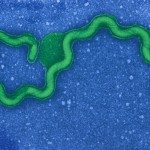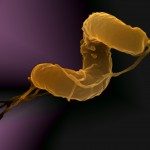Link to Pubmed [PMID] – 32849665
Link to DOI – 10.3389/fimmu.2020.02007
Front Immunol 2020 ; 11(): 2007
Leptospira (L.) interrogans are invasive bacteria responsible for leptospirosis, a worldwide zoonosis. They possess two periplasmic endoflagellae that allow their motility. L. interrogans are stealth pathogens that escape the innate immune recognition of the NOD-like receptors NOD1/2, and the human Toll-like receptor (TLR)4, which senses peptidoglycan and lipopolysaccharide (LPS), respectively. TLR5 is another receptor of bacterial cell wall components, recognizing flagellin subunits. To study the contribution of TLR5 in the host defense against leptospires, we infected WT and TLR5 deficient mice with pathogenic L. interrogans and tracked the infection by in vivo live imaging of bioluminescent bacteria or by qPCR. We did not identify any protective or inflammatory role of murine TLR5 for controlling pathogenic Leptospira. Likewise, subsequent in vitro experiments showed that infections with different live strains of L. interrogans and L. biflexa did not trigger TLR5 signaling. However, unexpectedly, heat-killed bacteria stimulated human and bovine TLR5, but did not, or barely induced stimulation via murine TLR5. Abolition of TLR5 recognition required extensive boiling time of the bacteria or proteinase K treatment, showing an unusual high stability of the leptospiral flagellins. Interestingly, after using antimicrobial peptides to destabilize live leptospires, we detected TLR5 activity, suggesting that TLR5 could participate in the fight against leptospires in humans or cattle. Using different Leptospira strains with mutations in the flagellin proteins, we further showed that neither FlaA nor Fcp participated in the recognition by TLR5, suggesting a role for the FlaB. FlaB have structural homology to Salmonella FliC, and possess conserved residues important for TLR5 activation, as shown by in silico analyses. Accordingly, we found that leptospires regulate the expression of FlaB mRNA according to the growth phase in vitro, and that infection with L. interrogans in hamsters and in mice downregulated the expression of the FlaB, but not the FlaA subunits. Altogether, in contrast to different bacteria that modify their flagellin sequences to escape TLR5 recognition, our study suggests that the peculiar central localization and stability of the FlaB monomers in the periplasmic endoflagellae, associated with the downregulation of FlaB subunits in hosts, constitute an efficient strategy of leptospires to escape the TLR5 recognition and the induced immune response.




